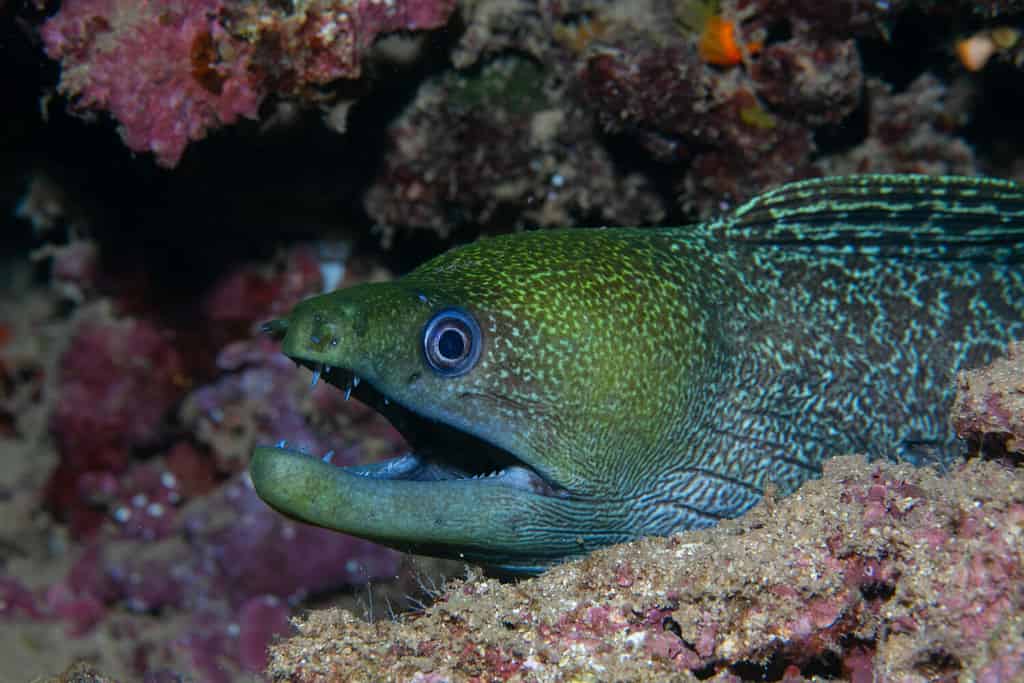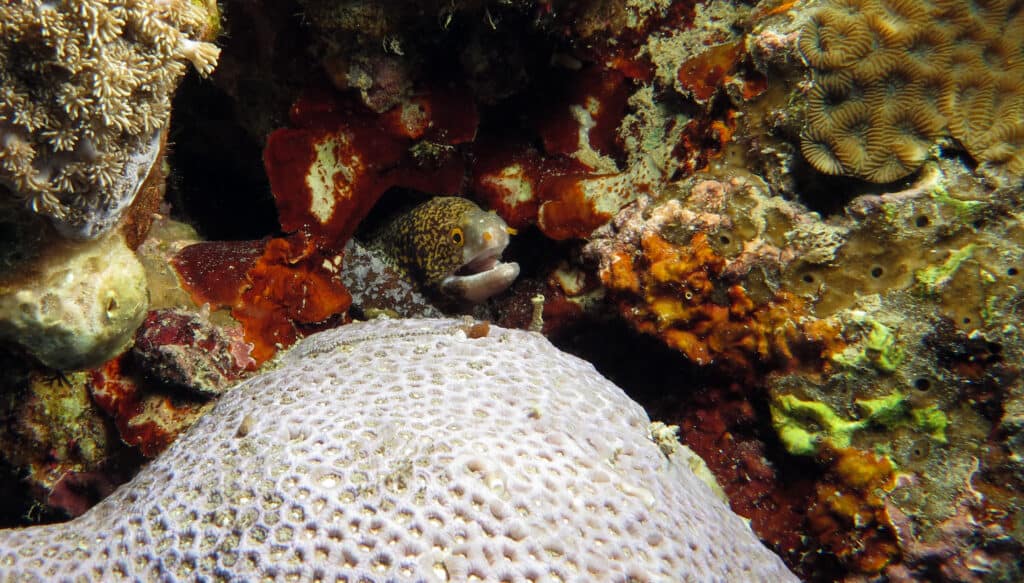
Eels are a fun and unique type of animal that you might not yet know a lot about, including the characteristics of freshwater vs. saltwater eel.
©RobJ808/Shutterstock.com
Anyone a fan of sushi likely knows that there are freshwater and saltwater eels out there. But it’s hard sometimes to understand exactly what the differences are between these two categories of eels besides the name. But if you want to compare freshwater vs. saltwater eel, you need to understand their key differences.
While there aren’t a lot of differences, there are enough to help you understand the unique characteristics of both types of eels. Keep reading below to find out more!
What Are Eels?
Eels are a type of fish. They are part of the Anguilliformes order, which has about 1,000 different species and 164 genera in it. True eels fall into this category. Some other elongated fish are called eels, even though they are not actually part of the group, such as spiny eels, swamp eels, electric eels, and wolf eels.
Eels are mostly nocturnal and can be found near soil under the ocean, lake, or river at many different depths. They enjoy burrowing in the sand or hiding between rocks and coral. Most eels also hibernate during the colder months, burying themselves in the substrate until it warms back up.
Eels are usually carnivores. They will eat small crustaceans, fish, and invertebrates that swim too close to their hiding holes. Eels move very fast and in many different directions and angles thanks to the 100 vertebrae that make up their spine.
Eels are found all over the globe in various freshwater bodies and saltwater bodies. Some eels even manage to live near the poles despite the cold weather. Many are threatened, near threatened, or endangered due to habitat loss and over-fishing.
Freshwater Eels
Freshwater eels are one you’re likely to come across inland, in rivers and lakes. In the US, there is only one species of freshwater eel, and that is the American eel. This species lives in estuaries and rivers primarily, but travels all the way to the Sargasso Sea to spawn. There are said to be roughly 19 species of freshwater eels throughout the world.
Like other eels, freshwater eels look and move a lot like snakes. They are very slimy and have pretty small fins. The slime is said to help protect them from pathogens and friction. The slime helps to protect them a little from predators too, but many birds and raccoons still manage to catch and eat these elongated fish.
Many are territorial. While they can make good pets, they don’t work well in a tank with other eels or smaller fish.
Saltwater Eels
Eels that live fully in the ocean are saltwater eels. The various species exist in a wide range of depths, temperatures, and habitats. There are thought to be at least 800 marine eels out there that have been identified so far.
The most common and well-known saltwater eels are the moray and conger eels. These are not specific types of eels, but categories of eels. The United States has species from both of these categories swimming in the oceans near land.
Like freshwater eels, these animals can be kept in aquariums. Some get quite large, so it’s important to find a species that stays a bit smaller. That way, it will be comfortable in a standard household aquarium.
Saltwater eels are also slimy and slippery, helping them evade predators. Some eels, like certain moray eels, are also poisonous as a secondary layer of protection. Unfortunately, that doesn’t protect them from all predators. You can still find groupers, barracuda, and sharks predating on these marine animals.
The Four Key Differences Between Freshwater and Saltwater Eels
From a glance, you’d probably not be able to correctly identify a species as freshwater or saltwater. However, they do have some key differences that make them stand out. While saltwater eels are more variable and abundant, you can’t knock the interesting and powerful eels that live in freshwater.
1. They Live in Different Water Types

Some eels can be found in coral reefs, such as the one pictured above.
©Andrey_Kuzmin/Shutterstock.com
The most obvious difference between the two species of eel is where they live. As their names suggest, freshwater eels tend to prefer to stay in freshwater like lakes and rivers. Meanwhile, saltwater eels stay in the ocean.
However, there are times when freshwater eels enter the ocean. Freshwater eels are born in the ocean. When they get old enough to travel, they will make the journey back to the river or lake their parents came from. Then, when those eels reach maturity, they will go back to the ocean.
There, they will spawn. Most freshwater eels die shortly after spawning. This means that while freshwater eels spend seven or more years in freshwater, they do spend the first part of their lives and the last part of their lives in the shallows of the ocean. The word for this kind of animal is catadromous.
2. Some Saltwater Eels Can Handle Very Deep Water

Hiding in coral, the snowflake eel waits for its prey to move nearby.
©Paulo Violas/Shutterstock.com
When it comes to freshwater vs. saltwater eel, another main difference is the water depth they tend to live in. Most freshwater eels tend to prefer shallower water. By default, freshwater eels don’t have a whole lot of choice. When relegated to lakes and rivers, they don’t usually have water deeper than a few hundred feet.
Even when freshwater eels go to the ocean to breed and live as young eels, they prefer to stay in shallow waters. You won’t find freshwater eels very deep at all, and they usually stay near the entrances to rivers, though some freshwater eels can travel thousands of miles.
Some saltwater eels prefer shallower waters as well, such as many species of moray eel. However, some eels live quite deep. Most are found somewhere between 9,800 feet to 13,000 feet underwater. Some have been found much deeper, but it’s not as common.
3. Freshwater Eels Have Teeth, Scales, and Fins

If you look closely, freshwater eels have small scales.
©Rostislav Stefanek/Shutterstock.com
Saltwater and freshwater eels look a little different on the surface. Saltwater eels do not really have scales. While they do have fins, they aren’t very developed. Their faces may also be rounder.
Meanwhile, species of freshwater eels tend to have narrower and more pointed heads. They also have well-developed eyes. Unlike saltwater eels, they do have scales, though they are soft and thin. They may also have pectoral fins and small, granular teeth.
4. They Taste Different

Delicious unagi eel nigiri is a little different from delicious anago eel nigiri.
©MaryLucky/Shutterstock.com
Freshwater eels are a common and well-loved dish in many Asian countries, including Japan. It’s common to come across grilled eel eaten beside rice and vegetables in a bowl or a roll. Even Italy and Britain eat eel in pies or roasted in the oven. There are certain ways to prepare it to make sure you don’t eat their blood, which is toxic, but otherwise it’s easy enough to cook and eat.
Many people around the world understand freshwater vs. saltwater eel when it comes to taste and texture. If you’ve ever eaten unagi, you’ve had freshwater eel. These eels are considered to have a rich and bold flavor with a minimal fishy flavor. They are also very oily, and somehow firm and delicate at the same time. The eel used for unagi is called Japanese eel (Anguilla japonica).
Anago is saltwater eel. The taste is described as mild, not overwhelming. It has medium levels of oiliness and is considered soft and delicate. There are a few different eels that can be used to make anago, but the most common is the conger eel, which is actually a group of 14 different eels.
In Italy, an eel known as an Italian eel is commonly used. European eels are used in Britain. Both of which are freshwater eels. Many other European and Asian countries also have eel as a regular part of their meals. However, Japan and Japanese cuisine is the most common place to come across eel. Estimates are that Japan accounts for 70 percent of the total eel consumption in the world.
Summary of the Differences Between Freshwater and Saltwater Eels
| Rank | Difference | For Freshwater Eels | For Saltwater Eels |
|---|---|---|---|
| 1 | Water type | Freshwater | Saltwater |
| 2 | Depth | Stay in rather shallow water | Can be found thousands of feet below the ocean surface |
| 3 | Appearance | Have scales and extra fins | No scales and underdeveloped fins |
| 4 | Taste | Oily, firm, rich | Somewhat oily, soft, mild |
The photo featured at the top of this post is ©
Thank you for reading! Have some feedback for us? Contact the AZ Animals editorial team.






